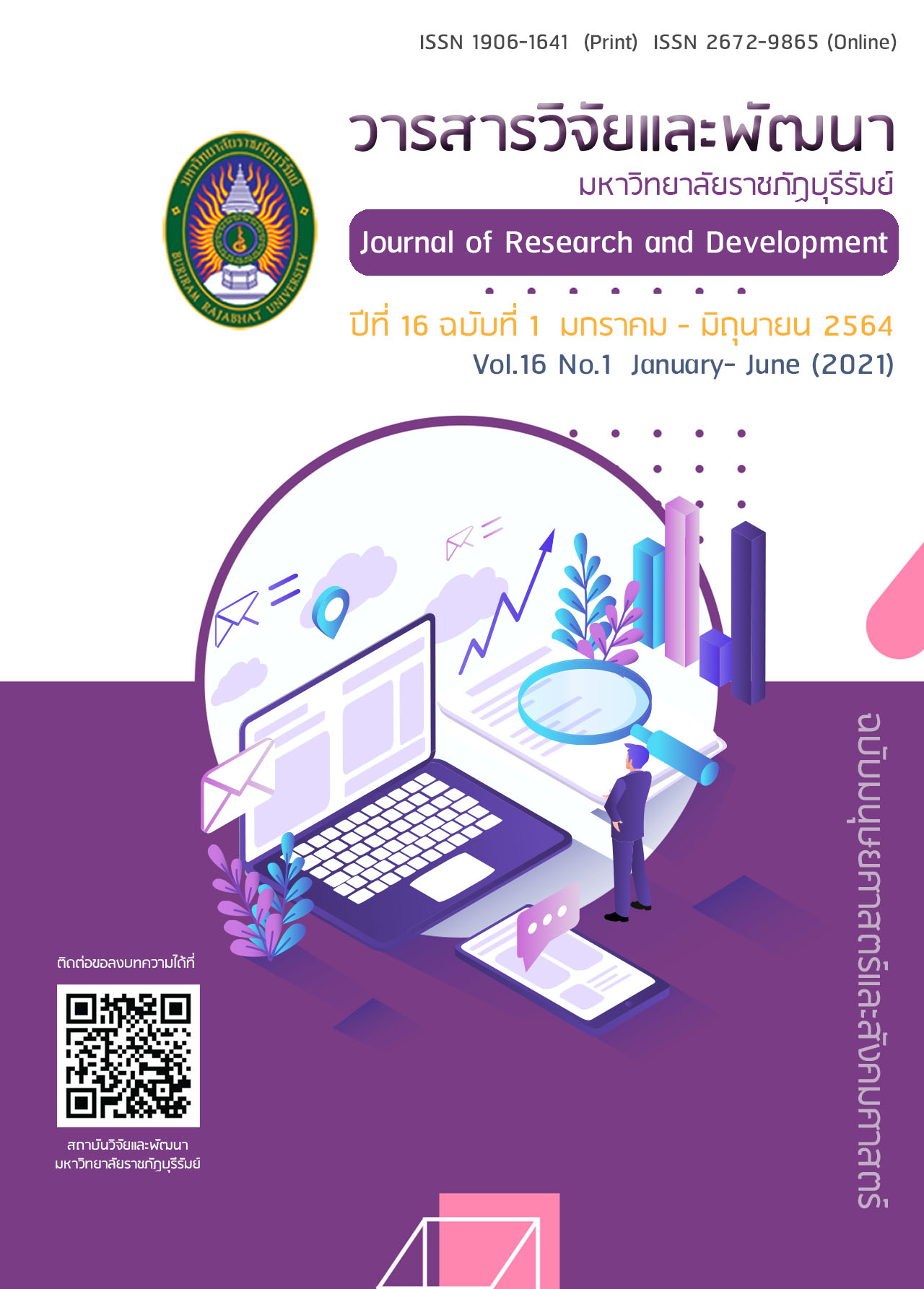Participatory Process of Data Management for Community Water User Groups: A Case Study of Five Places in OTOP Inno-Life Tourism Villages in Buriram Province
Main Article Content
Abstract
The purpose of this study was to investigate the participatory process of (1) data management and (2) water plan development for community water user groups--a case study of five places in OTOP Inno-Life Tourism Villages in Buriram Province. The studied areas were Thalung Lek, Khok Klang, Nong Sano, Chorakhe Mak, and Ban Yang District in Buriram Province. In-depth interview, focus group discussion, problems analysis, observation, and field surveying were used as research instruments. Data analysis was interpreted from the in-depth interview and brainstorming. The findings showed that the population of all five districts where the rainfall basically needed were farmers. Although, the low rainfall and insufficient reservoirs affected to the quantity and quality of agricultural products, each district still had a river flew through their places. Thus, they could have a participatory process of data management and well-organized on water supply for all of five groups with the cooperation from Local Administrative Organization, community leaders, district representatives, experts on water management, and representatives from Buriram Rajabhat University. The processes were: 1) to make understanding of water management in the community, 2) to settle the water management group,
3) to participate in the innovated stage of water management activity, to visit the Folk Philosopher Land under the concept “Water and E-san Community’s Way of Life”, and to join the study visit in the field of water management, 4) to cooperate with the data management stage of water users in the district areas to know about their roles and duties including water situation problems, and to make a spatial data used for water management and 5) to participate in water planning of water users’ group for getting the water plans of each district. There were Lam Huay Pan--a creek in Thalung Lek, Lamplaimat--the water plan area in Khok Klang, Chongmaew Canal--the water plan area in Nong Sano, Lam Pathia--a lake in Chorakhe Mak, and Lam Phang Chu --a canal in Ban Yang District.
Article Details
เนื่อหาและข้อมูลในบทความ เป็นความรับผิดชอบของผุ้แต่ง
บทความในวารสารเป็นลิขสิทธิ์ของวารสารวิจัยและพัฒนา มหาวิทยาลัยราชภัฏบุรีรัมย์
References
กรมส่งเสริมคุณภาพสิ่งแวดล้อม. (2556). โครงการวิจัยและพัฒนาระบบการน้าน้ากลับมาใช้ใหม่ สำหรับชุมชนขนาดเล็ก (Decentralized System). กรุงเทพฯ: กรมส่งเสริมคุณภาพ สิ่งแวดล้อม
กรมอุตุนิยมวิทยา. (2550). ภัยแล้ง. สืบค้นเมื่อ 22 ตุลาคม 2559, จาก: https://www.tmd.go.th/ agromet_drought_situation.php
กระทรวงมหาดไทย. (2560). คู่มือบริหารโครงการชุมชนท่งเที่ยว Otop นวัติวิถี. กรมการ ท่องเที่ยว กรุงเทพฯ
กล พรมสำลี. (2550). การจัดการน้ำระดับชุมชนกรณีบ้านผาชัน จังหวัดอุบลราชธานี.อุบลราชธานี
โกวิทย์ พวงงาม. (2545). การเสริมสร้างความเข้มแข็งของชุมชน. กรุงเทพฯ.
ณชพงศ จันจุฬา. (2552). การพัฒนาการมีสวนรวมของประชาชนในการจัดการลุ่มน้ำสายบุรี กรณีศึกษา การจัดการนาแบบรัฐและแบบชาวบ้านในพื้นที่ตำบลกาเยาะมาตี อำเภอ
บาเจาะ จังหวัดนราธิวาส. ปัตตานี: มหาวิทยาลัยสงขลานครินทร์ วิทยาเขตปัตตานี.
ปริศนา มัชฌิมา. (2556). การจัดการฐานข้อมูล. หลักสูตรเทคโนโลยีสารสนเทศ คณะวิทยาศาสตร์ และเทคโนโลยีมหาวิทยาลัยราชภัฏสวนดุสิต. กรุงเทพฯ.
สถาบันสารสนเทศทรัพยากรน้ำและการเกษตร (องค์การมหาชน). (2560). คู่มือการจัดการ ทรัพยากรน้ำชุมชน ตามแนวพระราชดำริด้วยวิทยาศาสตร์และเทคโนโลยี. กรุงเทพฯ : กระทรวงวิทยาศาสตร์และเทคโนโลยี.
สำนักงานคณะกรรมการพัฒนาการเศรษฐกิจและสังคมแห่งชาติ. (2555). แผนพัฒนาเศรษฐกิจและ สังคมแห่งชาติ ฉบับที่ 11, กรุงเทพฯ
สำนักงานจังหวัดบุรีรัมย์. (2559). แผนพัฒนา 4 ปี พ.ศ. 2561-2564. บุรีรัมย์
สุรศักดิ์ นุ่มมีศรี และคณะ. (2555).การจัดการทรัพยากรน้าเพื่อการอุปโภคและบริโภคในพื้นที่ลุ่ม น้ำยวม จังหวัดแม่ฮ่องสอน. สถาบันวิจัยและพัฒนา: มหาวิทยาลัยราชภัฏเชียงใหม่
อคิน รพีพัฒน์. (2527). การมีส่วนร่วมของชุมชนในการพัฒนาชนบทในสภาพสังคมและ วัฒนธรรมไทย. กรุงเทพฯ: ศักดิ์โสภาการพิมพ์

